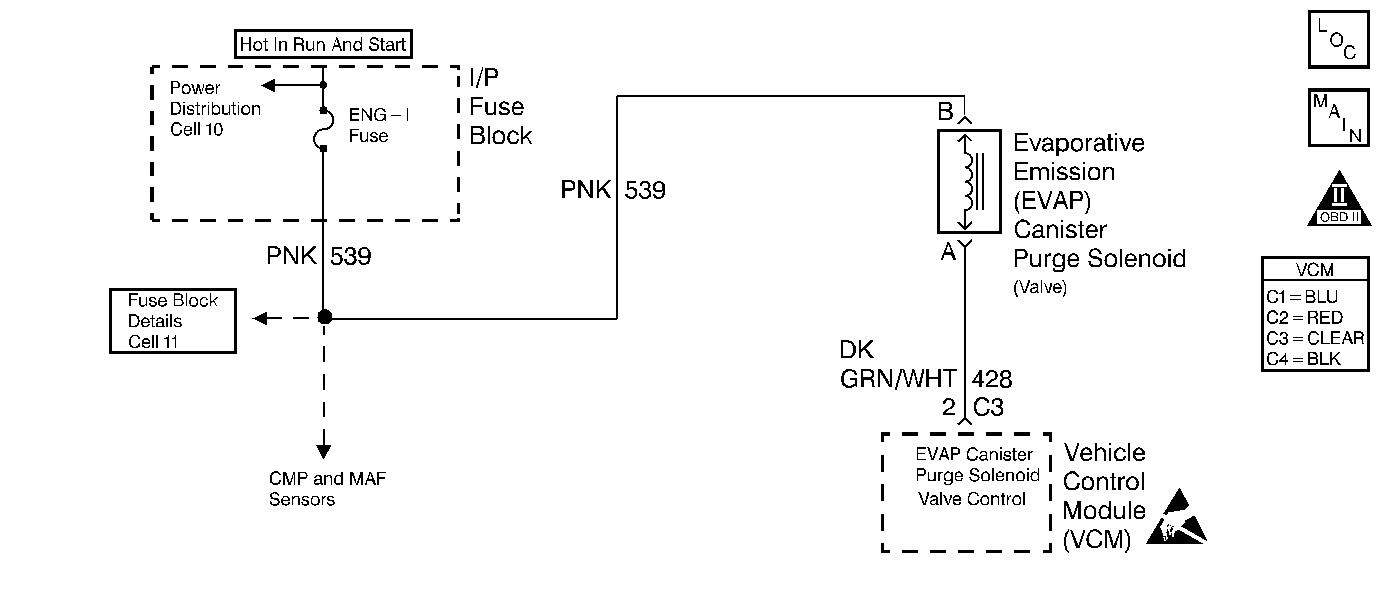
Circuit Description
The Evaporative System (EVAP) includes the following components:
| • | Fuel Tank |
| • | Fuel Pipes and Hoses |
| • | Vapor Lines |
| • | Evaporative Canister |
| • | Purge Lines |
| • | EVAP Purge Solenoid |
The EVAP Purge Solenoid valve allows manifold vacuum to purge the canister. The Vehicle Control Module (VCM) supplies a ground to energize the solenoid valve (purge "ON"). The EVAP Purge Solenoid control is Pulse Width Modulated (PWM) or turned ON and OFF several times a second. The duty cycle (pulse width) is determined by the engine operating conditions which include engine load, throttle position, engine coolant temperature, and ambient air temperature. The duty cycle is calculated by the VCM and the output is commanded when the appropriate conditions have been met.
There are no EVAP system DTCs.
Diagnostic Aids
When there is continuous purge of the EVAP canister containing fuel vapors, a rich condition with a higher IAC Position value and a lower than normal Long Term Fuel Trim value may be seen. This is similar to a leaking fuel injector.
When there is continuous purge of the EVAP canister not containing fuel vapors (new canister, disconnected purge line, or disconnected vapor lines), a lean condition with a low IAC Position value and a higher than normal Long Term Fuel Trim value may be seen. This is similar to a vacuum leak.
Check for the following:
| • | EVAP lines for charcoal contamination |
| • | Damaged EVAP canister purge solenoid O-ring |
| • | Cracked or punctured EVAP Canister |
| • | Blocked air separator |
| • | Damaged vacuum line, purge line, vent line, or fuel tank vapor lines |
| • | Poor connection at VCM |
| • | Damaged harness or connectors |
Test Description
Numbers below refer to the step numbers on the Diagnostic Table
-
Checks to see if a vacuum source is present, along with certain conditions before the purge solenoid is commanded ON. Also shows a change of vacuum as the purge solenoid is being cycled
-
Checks for power to the solenoid, the ground circuit, the connections at the purge solenoid and the solenoid itself.
-
Checks for an open or grounded ignition feed circuit.
-
Checks for an open EVAP canister purge control circuit or faulty control module.
Step | Action | Value(s) | Yes | No |
|---|---|---|---|---|
1 | Was the Powertrain On-Board Diagnostic (OBD) System Check performed? | -- | ||
Is vacuum present when the solenoid is energized? | 45°C (113°F) 2000 RPM | |||
Is the test light ON? | -- | |||
Is the test light ON? | -- | |||
Is the test light ON? | -- | |||
6 | Check the purge line to the EVAP canister and repair if necessary. Was a problem found? | -- | Go to Diagnostic Aids | |
7 |
Was a problem found? | -- | ||
8 | Repair the open in the ignition feed circuit. Refer to Wiring Repairs in Wiring Systems. Is the action complete? | -- | -- | |
9 | Repair the open in the EVAP canister purge control circuit to the EVAP canister purge solenoid. Refer to Wiring Repairs in Wiring Systems. Is the action complete? | -- | -- | |
10 |
Was a problem found? | -- | ||
11 | Replace the EVAP canister purge solenoid. Refer to EVAP Canister Purge Solenoid Valve Replacement . Is the action complete? | -- | -- | |
12 |
Is the action complete? | -- | -- | |
13 |
Does the EVAP Canister Purge Solenoid operate properly? | -- | System OK |
